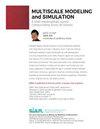半透界面陷阱的三维窄捕获问题
IF 1.6
4区 数学
Q2 MATHEMATICS, INTERDISCIPLINARY APPLICATIONS
引用次数: 3
摘要
在本文中,我们分析了单个布朗粒子在包含一组小的球形陷阱的三维(3D)有界域中扩散的窄捕获问题。每个捕集器的边界表面设为半透膜。也就是说,通过界面的连续通量与概率密度中相关的跳变不连续成正比。比例常数与渗透率一致。此外,我们允许扩散率和化学势在每个界面上的不连续;后者引入了方向偏差。我们还假设粒子可以在每个阱的内部以一定的泊松速率被吸收(捕获)。在小陷阱极限下,我们使用匹配渐近和格林函数方法计算了被一个陷阱吸收的分裂概率和无条件平均首次通过时间(MFPT)。然而,分析的细节取决于各种参数如何与特征陷阱半径成比例。在标度下,我们证明了半透膜与完全吸收阱的标准例子相比,降低了每个球形阱的有效电容。后一种情况是恢复在对偶极限,并等于一个球的本征电容,即半径。我们还说明了当(慢吸收)或(低渗透率)时如何修改渐近展开。最后,我们考虑单向限制,其中每个界面只允许粒子流入陷阱。然后,捕集器以恒定的反应速率充当部分吸收表面。结合渐近分析和部分反应表面的基于相遇的公式,我们展示了如何根据电容来分析广义表面吸收机制(非马尔可夫)。因此,我们建立了一个广泛的窄捕获问题,可以表征的有效电容的陷阱。本文章由计算机程序翻译,如有差异,请以英文原文为准。
The 3D Narrow Capture Problem for Traps with Semipermeable Interfaces
In this paper we analyze the narrow capture problem for a single Brownian particle diffusing in a three-dimensional (3D) bounded domain containing a set of small, spherical traps. The boundary surface of each trap is taken to be a semipermeable membrane. That is, the continuous flux across the interface is proportional to an associated jump discontinuity in the probability density. The constant of proportionality is identified with the permeability . In addition, we allow for discontinuities in the diffusivity and chemical potential across each interface; the latter introduces a directional bias. We also assume that the particle can be absorbed (captured) within the interior of each trap at some Poisson rate . In the small-trap limit, we use matched asymptotics and Green’s function methods to calculate the splitting probabilities and unconditional mean first passage time (MFPT) to be absorbed by one of the traps. However, the details of the analysis depend on how various parameters scale with the characteristic trap radius . Under the scalings and , we show that the semipermeable membrane reduces the effective capacitance of each spherical trap compared to the standard example of totally absorbing traps. The latter case is recovered in the dual limits and , with equal to the intrinsic capacitance of a sphere, namely, the radius. We also illustrate how the asymptotic expansions are modified when (slow absorption) or (low permeability). Finally, we consider the unidirectional limit in which each interface only allows particles to flow into a trap. The traps then act as partially absorbing surfaces with a constant reaction rate . Combining asymptotic analysis with the encounter-based formulation of partially reactive surfaces, we show how a generalized surface absorption mechanism (non-Markovian) can be analyzed in terms of the capacitances . We thus establish that a wide range of narrow capture problems can be characterized in terms of the effective capacitances of the traps.
求助全文
通过发布文献求助,成功后即可免费获取论文全文。
去求助
来源期刊

Multiscale Modeling & Simulation
数学-数学跨学科应用
CiteScore
2.80
自引率
6.20%
发文量
45
审稿时长
6-12 weeks
期刊介绍:
Centered around multiscale phenomena, Multiscale Modeling and Simulation (MMS) is an interdisciplinary journal focusing on the fundamental modeling and computational principles underlying various multiscale methods.
By its nature, multiscale modeling is highly interdisciplinary, with developments occurring independently across fields. A broad range of scientific and engineering problems involve multiple scales. Traditional monoscale approaches have proven to be inadequate, even with the largest supercomputers, because of the range of scales and the prohibitively large number of variables involved. Thus, there is a growing need to develop systematic modeling and simulation approaches for multiscale problems. MMS will provide a single broad, authoritative source for results in this area.
 求助内容:
求助内容: 应助结果提醒方式:
应助结果提醒方式:


